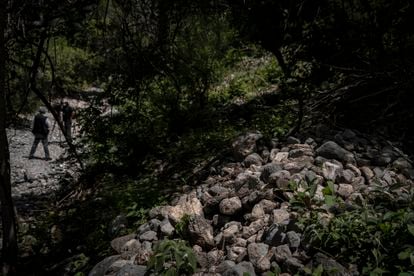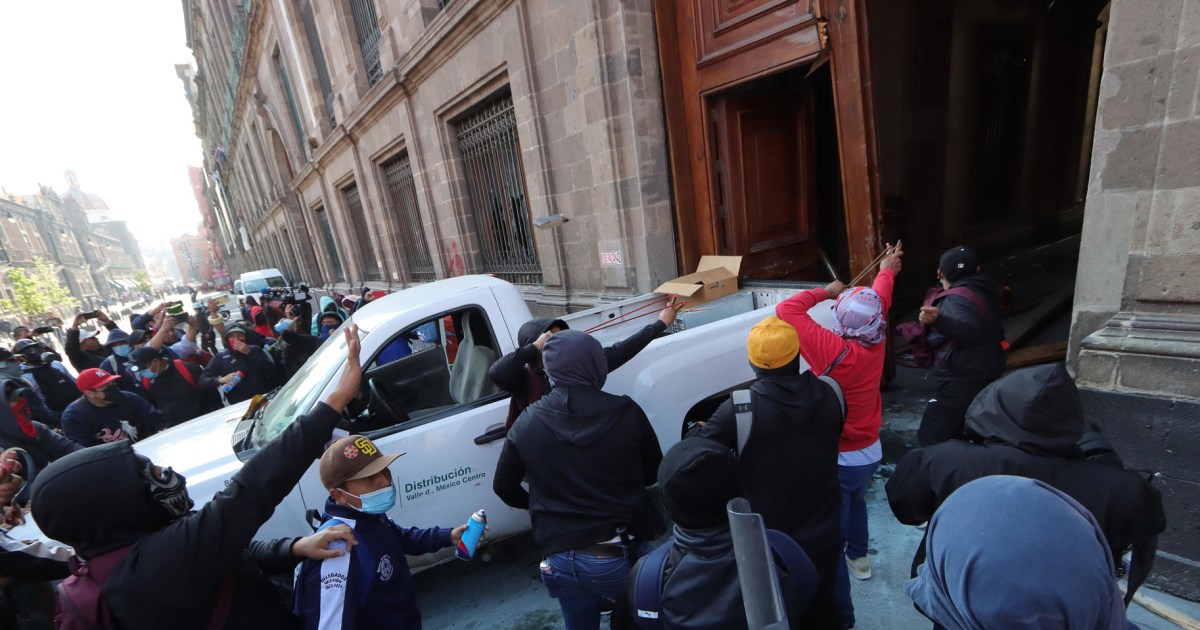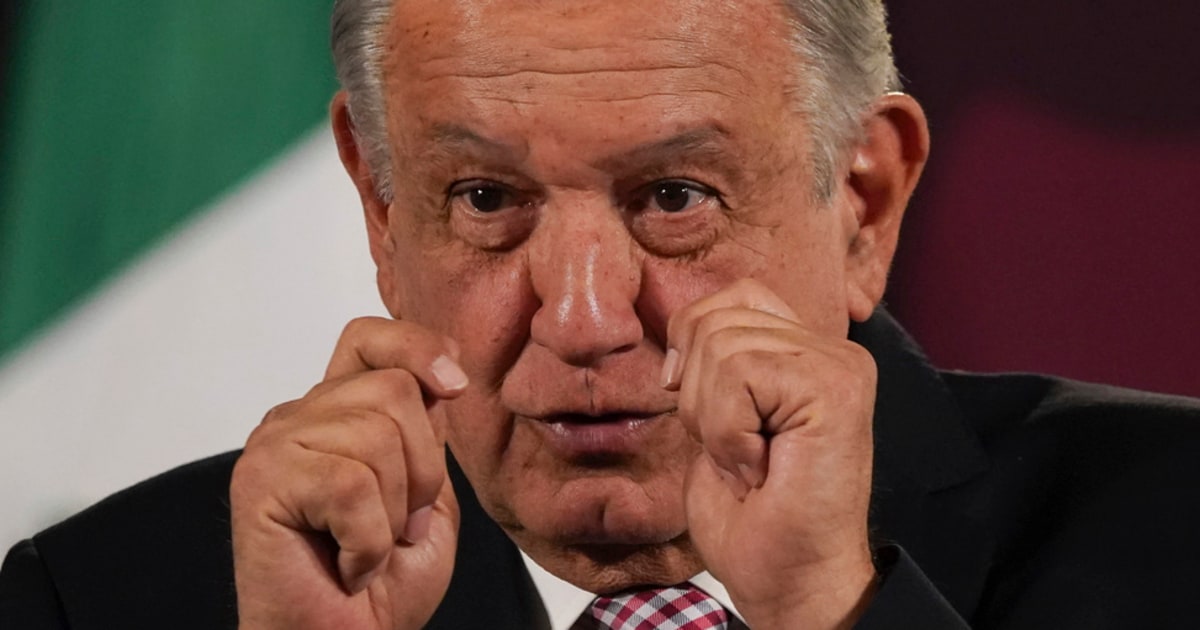A member of the Attorney General's Office walks through the Carnicería ravine, in Cocula (Guerrero), where the remains of two of the Ayotzinapa students, who disappeared in 2014, were found.
Guarded by swarms of flies and by the National Guard, the Carnicería ravine is a hostile place. This property in the Sierra de Guerrero is the central scene of the Mexican Prosecutor's Office in the search for the 43 Ayotzinapa normalista students who disappeared in 2014. In this land, among thorny bushes, two remains that belonged to Christian Rodríguez and Jhosivani Guerrero were recovered. From the first was a fragment of the foot — it weighed barely a gram — from Guerrero, a lumbar vertebra. In the hypothesis that the Government manages, the young people did not die here. His remains were dumped in the ravine after the night of September 26, when they suffered together with their companions a coordinated attack by the security forces and organized crime in the city of Iguala.What happened to the students that early morning seven years ago? Why were they hunted and disappeared? And above all, where are they? In this place of bushes and litter, shown for the first time to the press, the Prosecutor's Office has been looking for the answers.
The access is stubborn and the procession advances slowly along the dirt road.
Omar Gómez, the prosecutor in charge of the
Ayotzinapa case
, and his team have spent a year and a half working non-stop in the ravine.
Until this Tuesday they had never opened it to people outside the investigation.
They do it because they have finished their work here and now they are focusing their search on two new scenarios - THE COUNTRY revealed that one of them is the road that goes from the municipality of Mezcala, also in Guerrero, to the mines of Carrizalillo and its surroundings.
More information
"We want them to explain to us how Christian's bone got to the ravine"
"There was no interest in us going to La Carnicería"
The special unit of the Prosecutor's Office for the case, constituted with the entrance to the National Palace of Andrés Manuel López Obrador, has been completely unmarked from the investigation carried out by the Government of Enrique Peña Nieto (2012-2018). Gómez describes the version of the previous Executive as a montage created to shelve the matter. When they put themselves in charge of the case, he says, the search for the students was reactivated and new lines of investigation were opened to find out what happened to them. At the center of both investigations, they placed the Carnicería ravine.
The researchers arrived for the first time on November 19, 2019. A series of sources pointed out that in this area, located about 28 kilometers from Iguala, "there was intense activity that night in 2014." The prosecutor explains that several witnesses - now protected and at the time participating in the disappearance of the boys - told them: "Look in this area." From the top of the road that leads to the Cocula garbage dump and at various points, according to the Prosecutor's Office, the remains of some normalistas had been thrown into the ravine in a sack.
That bag, white in color and synthetic material, was all the signage that the investigators received, they should start looking there. They found nothing on the first or second day. On November 26, next to a tree, they located a small trace of that white sack, which was no longer complete after the passage of time. There were the first bone fragments, there were about 70, but none of them contained enough genetic material to be identified. From that central point they traced the area to be examined.
"The Carnicería ravine represented a hope for us to continue working in the search for the students," says the prosecutor. Since his disappearance in 2014 and until his arrival in the ravine in 2019, only the trace of one of the 43 had been found: a bag with Alexander Mora's remains, presented at the beginning of the investigation with Peña Nieto and allegedly found in the San Juan river. “It has been extremely important to be able to reach the ravine,” says Omar Gómez, who attributes the finding to having managed to “break the silence” that was around the case.
Experts and archaeologists combed eight square kilometers. They tore up weeds with machetes, moved each stone that hindered the terrain one by one, marked 20-meter units, which they later divided into grids, and dug, sifted kilos of earth, and found. In total, 187 bone fragments, of which 22 were sent to the laboratory in Innsbruck, in Austria, to analyze their genetic material, two were positive: they belonged to the students. "When they appeared, you realized that all the work of months and months was worth it," one of the team's archaeologists tells EL PAÍS, while moving fast, familiar with the terrain.
Christian was 19 years old when he disappeared in Iguala.
A one-centimeter fragment of his Achilles heel was located in the ravine in late 2019. It was so small that archaeologists only discovered it when they sifted through a pile of dirt.
"It's a needle in a haystack," says the Undersecretary for Human Rights, Alejandro Encinas, pointing with his arms at a complex and populated mountain in which a tiny bone was found.
It was halfway up the hill of the ravine, about 60 meters from the initial search point, it had not been burned but it was cracked from exposure to the sun and the elements;
it was named clue number 15.
This is the point of the ravine where the bone fragment belonging to student Christian Rodríguez was found in 2019.
Nayeli Cruz
On October 22, 2020, and after some waterspouts that had stirred part of the terrain, the only complete bone in the entire ravine was located: a lumbar vertebra. Nor had it been burned. The prosecutor Omar Gómez took her personally to Innsbruck. With a 99% chance, that bone had belonged to Joshivani Guerrero. The finding prompted relatives to assume what the clues pointed out. "Without a foot you can live, but finding a vertebra implies that that person, necessarily, is no longer alive," say the researchers firmly.
In the shelter of a precarious shadow, the undersecretary sits this sultry September morning on a blackish stone, he says it is already his. At this same point - a couple of meters from where the fragment of Christian Rodríguez was located - on May 13 of this year, the prosecutor's team gathered the families and together they toured the ravine to share the results with them. “Christian's parents came; those of Joshivani no, because they are already big. It was very emotional, ”Encinas and Gómez agree.
The remains of the two boys appeared on the surface, not buried, which for the Prosecutor's Office confirms the testimonies that they had been thrown from the top of the ravine.
They are the only two student tests in which the chain of custody has been respected.
Regarding the discovery of Alexander Mora's bone in 2014, doubts still linger where it really came from.
A new investigation without "historical truth"
Going up the path that leads to the Carnicería ravine is the Cocula garbage dump. 800 meters. That was the key scenario on which the Attorney General's Office (PGR) - the former prosecutor's office - based what it called the "historical truth." It claimed that the Guerreros Unidos criminal group in collusion with municipal, state and ministerial security forces burned the 43 boys in the garbage dump and then dumped the remains into the San Juan River. To support this version, the director of the PGR, Jesús Murillo Karam, and the former director of the Criminal Investigation Agency, Tomás Zerón, -now a fugitive from justice-, showed video confessions of cartel members and the discovery of the bone of Alexander Mora.
This version has been described as an invention by the prosecutor Gómez, who considers that the statements of the hitmen were obtained by illicit means, such as torture, and that the evidence was "sown." The Argentine Forensic Anthropology Team (EAAF), which was working on the case with the PGR in those days of 2014, was not allowed to be present when they allegedly removed Alexander's bone from the river; The Public Ministry official who supposedly signed the record of extraction of the fragment was not there either.
The San Juan river is far from the Carnicería ravine. And the garbage dump is not close either. The ascent up the path that joins these two points is slow and expensive. The branches and stones that have invaded the space hit the vans. And that the area is now cleaner and clearer after a year and a half of search work, the researchers add. The Prosecutor's Office led by Gómez is clear: the perpetrators never came to the garbage dump to dump the students' remains. They stayed earlier, lower down.
The new research team has a hypothesis of what happened on the night of September 26-27, 2014, but is still working on verifying it. They have been deployed in 53 scenarios and are now delving into a line of investigation focused on incinerators, some “controlled burning places”, as defined by the prosecutor, where the bodies of the students could have been cremated. “Almost seven years have passed since these spaces were used, what findings can we find? Possibly none, but it is a line that we keep open ”, pointed out Gómez. It does not specify where these sites are, but at the time in 2014 there was talk of the Iguala funeral homes.
The prosecutor is aware that they may never be able to reconstruct exactly what happened since the 43 students of the Isidro Burgos Rural Normal School were forced to get off two of the buses in which they were, were mounted on police patrol cars and they vanished.
But while trying, he says, that "progress is made in access to justice and the truth of the
Ayotzinapa case
."
The Barranca de la Carnicería, located in the Sierra de Guerrero, the central scene of the Prosecutor's Office in the search for the 43 students of Ayotzinapa.Nayeli Cruz
Subscribe here
to the
newsletter
of EL PAÍS México and receive all the informative keys of the current situation of this country








/cloudfront-eu-central-1.images.arcpublishing.com/prisa/L2GUYXJ3FVDMXESOLU4CJ4VQZY.jpg)
/cloudfront-eu-central-1.images.arcpublishing.com/prisa/ROUPNH6I55BCHIXUOGEHSJZB6Y.jpg)


/cloudfront-eu-central-1.images.arcpublishing.com/prisa/KMEYMJKESBAZBE4MRBAM4TGHIQ.jpg)


